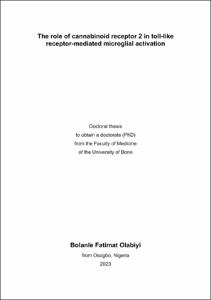Olabiyi, Bolanle Fatimat: The role of cannabinoid receptor 2 in toll-like receptor-mediated microglial activation. - Bonn, 2023. - Dissertation, Rheinische Friedrich-Wilhelms-Universität Bonn.
Online-Ausgabe in bonndoc: https://nbn-resolving.org/urn:nbn:de:hbz:5-72043
Online-Ausgabe in bonndoc: https://nbn-resolving.org/urn:nbn:de:hbz:5-72043
@phdthesis{handle:20.500.11811/11016,
urn: https://nbn-resolving.org/urn:nbn:de:hbz:5-72043,
author = {{Bolanle Fatimat Olabiyi}},
title = {The role of cannabinoid receptor 2 in toll-like receptor-mediated microglial activation},
school = {Rheinische Friedrich-Wilhelms-Universität Bonn},
year = 2023,
month = aug,
note = {Cannabinoid receptor 2 (CB2) modulates microglial responses to inflammatory stimuli. Expression of CB2 is known to increase during chronic inflammation and thus exacerbate neurodegeneration. Results from previous studies in our lab demonstrated that genetic deletion of CB2 inhibits microglial activation during inflammatory stimulation of toll-like receptors (TLRs) or in neurodegenerative conditions. However, the molecular mechanism is unclear. More so, we cannot rule out the developmental effects of constitutive CB2 knockout, which could have triggered a compensatory outcome in CB2-/- mice. Therefore, in this study, we aimed to investigate, on the one hand, the molecular mechanism by which CB2 mediates TLR-induced microglial activation and on the other hand, to compare the effects of acute pharmacological inhibition of CB2 to CB2-/- in response to inflammatory stimulation of TLRs.
Our data showed that after TLR3 and TLR4 stimulation with PolyI:C and LPS/IFN-g respectively in microglia, CB2 deletion caused decreased inflammatory cytokine secretion and reduced Iba1 intensity, whereas TLR9 stimulation with CpG did not affect the tested parameters in CB2-/- microglia compared to WT. We showed a striking decrease in p38 phosphorylation in CB2-/- microglia compared to WT after TLR3/4 stimulation. The pharmacological findings revealed that in contrast to CB2-/-, CB2-specific antagonist SR144528 had little or no effect on TLR3/4-induced activation in primary microglia or organotypic hippocampal slice cultures at nanomolar concentrations (1 nM and 10 nM). We showed that SR144528 did not alter TLR-mediated microglial cytokine secretion, Iba1/CD68 staining intensities or morphology at nanomolar concentrations. Although SR144528 suppressed LPS/IFN-γ-induced microglial activation at 1 μM, this anti-inflammatory effect was not dependent on CB2 receptors and exceeded the Ki on CB2 receptors by more than a thousand-fold. Finally, our seahorse metabolic analysis indicated that CB2-/- alters metabolic rewiring in unstimulated and LPS/IFN-γ stimulated microglia, whereas CB2 blockade does not affect the metabolic effects.
Taken together, our findings suggest that pharmacological blockade of CB2 does not mimic the anti-inflammatory effects observed in the CB2-/- microglia after TLR stimulation. Therefore, we propose that the lack of CB2 receptors probably triggered an adaptive mechanism, making microglia less responsive to TLR stimulation.},
url = {https://hdl.handle.net/20.500.11811/11016}
}
urn: https://nbn-resolving.org/urn:nbn:de:hbz:5-72043,
author = {{Bolanle Fatimat Olabiyi}},
title = {The role of cannabinoid receptor 2 in toll-like receptor-mediated microglial activation},
school = {Rheinische Friedrich-Wilhelms-Universität Bonn},
year = 2023,
month = aug,
note = {Cannabinoid receptor 2 (CB2) modulates microglial responses to inflammatory stimuli. Expression of CB2 is known to increase during chronic inflammation and thus exacerbate neurodegeneration. Results from previous studies in our lab demonstrated that genetic deletion of CB2 inhibits microglial activation during inflammatory stimulation of toll-like receptors (TLRs) or in neurodegenerative conditions. However, the molecular mechanism is unclear. More so, we cannot rule out the developmental effects of constitutive CB2 knockout, which could have triggered a compensatory outcome in CB2-/- mice. Therefore, in this study, we aimed to investigate, on the one hand, the molecular mechanism by which CB2 mediates TLR-induced microglial activation and on the other hand, to compare the effects of acute pharmacological inhibition of CB2 to CB2-/- in response to inflammatory stimulation of TLRs.
Our data showed that after TLR3 and TLR4 stimulation with PolyI:C and LPS/IFN-g respectively in microglia, CB2 deletion caused decreased inflammatory cytokine secretion and reduced Iba1 intensity, whereas TLR9 stimulation with CpG did not affect the tested parameters in CB2-/- microglia compared to WT. We showed a striking decrease in p38 phosphorylation in CB2-/- microglia compared to WT after TLR3/4 stimulation. The pharmacological findings revealed that in contrast to CB2-/-, CB2-specific antagonist SR144528 had little or no effect on TLR3/4-induced activation in primary microglia or organotypic hippocampal slice cultures at nanomolar concentrations (1 nM and 10 nM). We showed that SR144528 did not alter TLR-mediated microglial cytokine secretion, Iba1/CD68 staining intensities or morphology at nanomolar concentrations. Although SR144528 suppressed LPS/IFN-γ-induced microglial activation at 1 μM, this anti-inflammatory effect was not dependent on CB2 receptors and exceeded the Ki on CB2 receptors by more than a thousand-fold. Finally, our seahorse metabolic analysis indicated that CB2-/- alters metabolic rewiring in unstimulated and LPS/IFN-γ stimulated microglia, whereas CB2 blockade does not affect the metabolic effects.
Taken together, our findings suggest that pharmacological blockade of CB2 does not mimic the anti-inflammatory effects observed in the CB2-/- microglia after TLR stimulation. Therefore, we propose that the lack of CB2 receptors probably triggered an adaptive mechanism, making microglia less responsive to TLR stimulation.},
url = {https://hdl.handle.net/20.500.11811/11016}
}






